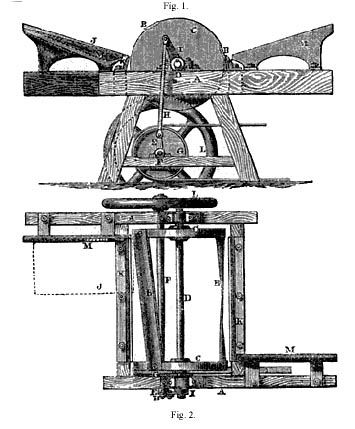Quarrying Techniques - Machinery for
Dressing Slate: J.W. Greaves
Carnarvon. Patent dated May 18,
1861.
THE machinery or apparatus for dressing slates,
introduced by the patentee, affords accommodation for two workmen
at the same machine, thus producing double the amount of work
hitherto accomplished in machines of this description. According
to this invention, the cutter or cutters is or are mounted at a
slight angle or inclination to the axial centre line of the main
shaft of the machine upon a pair of holding discs or frames. The
cutting edges of the cutter or cutters are in opposite
directions, so that by imparting a circular reciprocating motion
to the discs, they will alternately act upon and dress the edges
of the slates, which are presented to them, upon stationary
cutters or knives at each side of the machine.

Fig. 1 of the accompanying engravings is a side or end
elevation of this improved double action slate dressing machine;
and fig. 2 is a corresponding plan of the same. A is the main
framing of the machine, and B are two knives or cutters mounted
on the discs, c, fast on the shaft, D, the knives being at an
angle with the shaft in place of being parallel therewith. A
reciprocating motion is imparted to the knives, B, by a crank or
cranks at E, on the crank shaft, F, to which a rotatory motion is
imparted by a strap and driving pulley, Q, or by any other
suitable contrivance. H is a connecting rod, serving to connect
the rotating crank, E, with the longer and reciprocating crank,
T, fast on the cutter shaft, D. The rotation of the crank, E,
imparts the desired i oscillating or circular reciprocatory
motion to the cutters, which have their cutting edges in opposite
directions, and act alternately upon slates, as at J, laid on the
two stationary cutters, KL. L is a fly wheel fast on the driving
shaft, F, and M are the gauges for determining the proper
dimensions of the slates. It is obvious that in lieu of two
reciprocating cutters one such cutter only might be employed,
each edge acting alternately as a cutting edge.
From: The Practical Mechanic's Journal, 01/04/1862
|